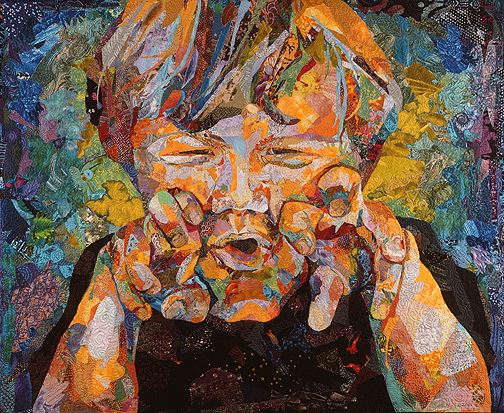
2000
I’d had a stressful year. We were raising a toddler. I had published my first book, Freestyle Quilts. And we had just completed a move from one Maine town to another.
Back then I was creating quilts to sell. I don’t do that anymore. Occasionally they sell, but I don’t create them in order to sell. There’s a big difference stress-wise. I’d just finished a big coral reef commission after doing several smaller ones (plus one for the book). They required lots of exacting detail, including quilting each portion of the piece in a different color thread to either blend in or add detail. This meant changing the thread in my machine constantly. They were challenging and rewarding but very “tight” artistically.
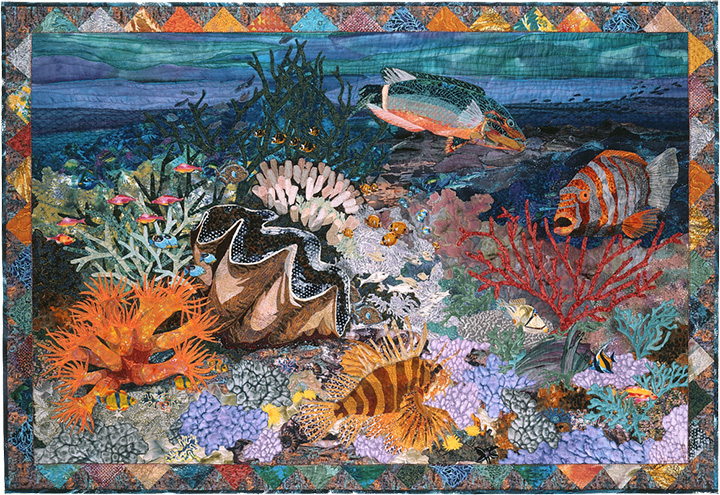
I needed to loosen up mentally, emotionally, and artistically.
It seemed like the perfect time for a fresh start, but how exactly?
I consider my work painting with fabric. If I were a painter and wanted to loosen up I might delve into impressionistic painting, dabs of color that look abstract when seen up close, yet when you back away they come together to form an image. Monet is a good example.
So how would I approximate that same technique in fabric?
One option was to sit and cut up larger pieces fabric, which would take a lot of time. I like to work in a more immediate way, so that didn’t appeal to me. Then I remembered that in storage I had a box of scraps that I’d gathered as I was packing up our old house. For ten years, I’d collected scraps from each quilt I made, storing those bits and pieces in little bags. As I was packing and came across them, I consolidated the bags into a single box.
My husband, ready to scream from the stress of moving all my other stuff, almost had to be sedated when I told him that the box of scraps was going, too.
After choosing the method of construction, choosing a subject was almost predestined. Since coming into our lives three years previously, our son Sam had been the personification of relentless energy, keeping his two work-at-home parents hopping 24/7. What better way to recognize that spirit than to capture it in a style would be equally energetic?
I guess a lot of kids go through a dinosaur phase. Well, at two and a half Sam was correcting the pronunciation of the babysitters who read to him from his dino books. Compsognathus. Brachiosaurus. Parasaurolophus. His little tongue had no trouble wrapping around the most convoluted names.
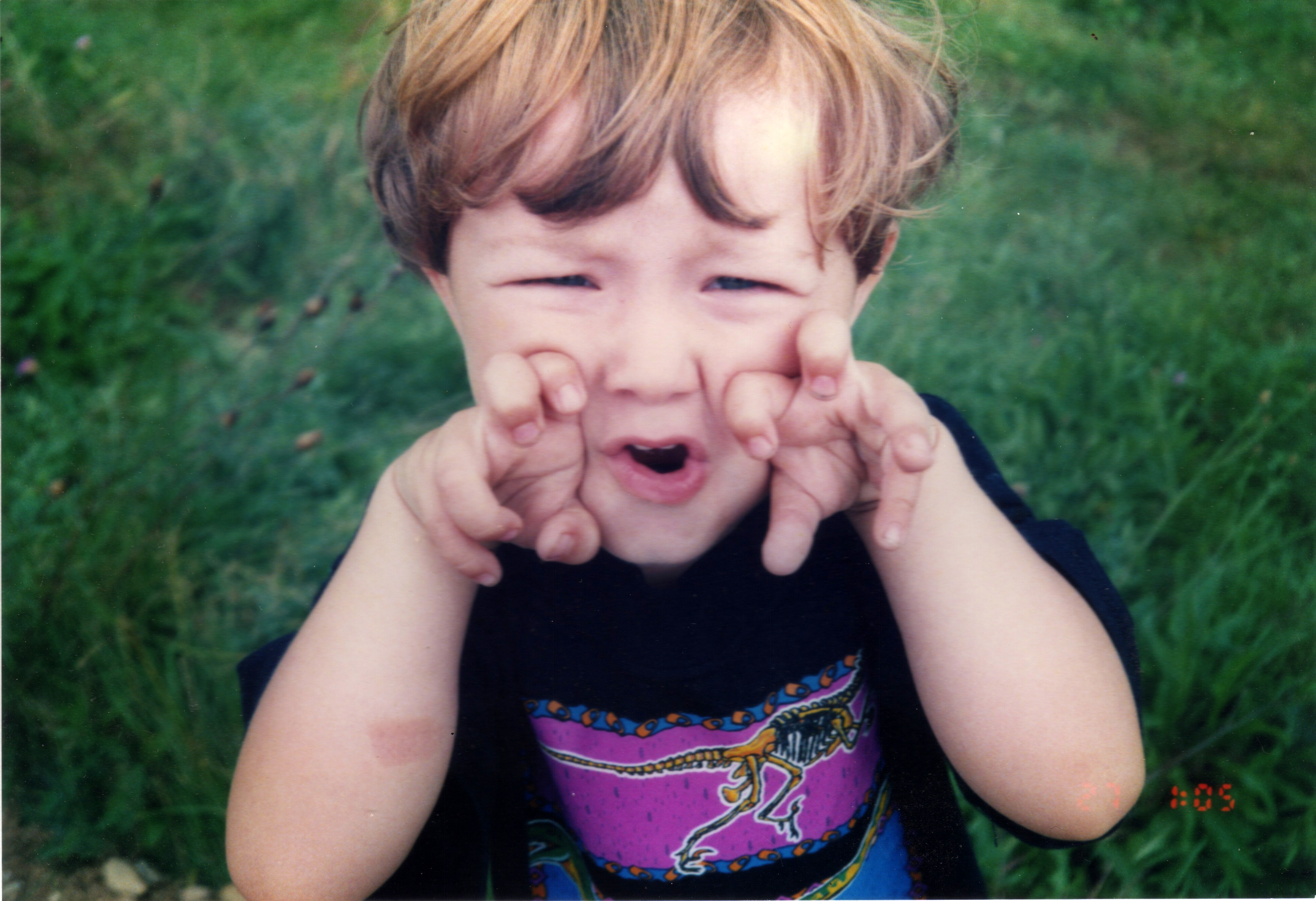
I had a picture of him pretending to be a Tyrannosaurus Rex. He’s roaring and his pudgy little fingers are curled in claws. The picture was perfect.
I found the cardboard box of scraps and cut it open. There was my impressionistic palette. I plunged my hands into a bushel of random colors, shapes, patterns, sizes. Using that box exclusively I started in on that portrait of Sam.
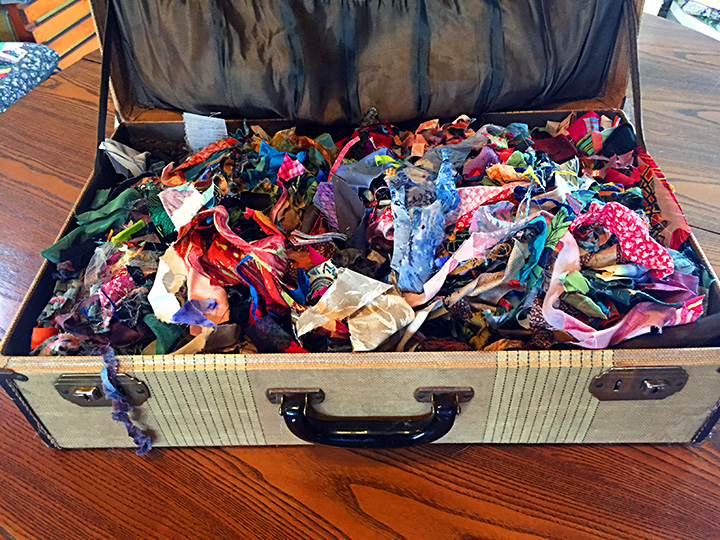
I worked big. I hadn’t realized until then how much easier it is to work on a large scale than a life-size or smaller portrait of a person. Sam’s portrait was big enough to give room to play. It was by far the biggest scale I had worked on, maybe four or five times bigger. Which is why I now tell my students that bigger is better.
I didn’t cut the shapes to fit. Mostly, I used them as I found them, only occasionally snipping a corner here or there, especially on the edges of the image. I also didn’t pay too much attention to color. I made my choices based mostly on value, after all “rainbow” was Sam’s favorite color at the time.
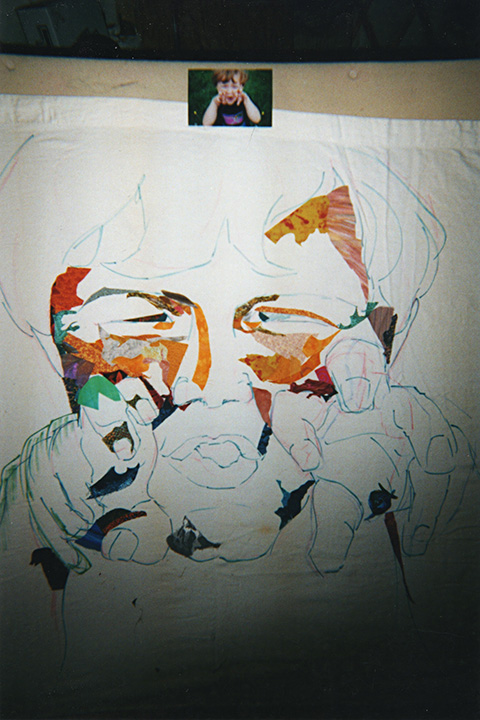
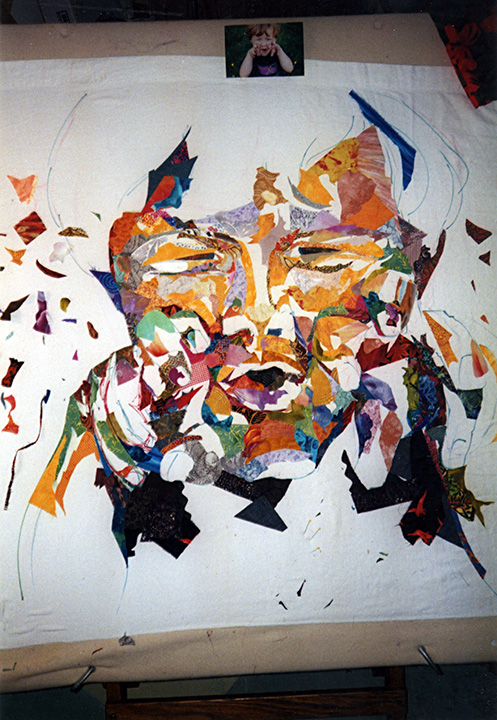
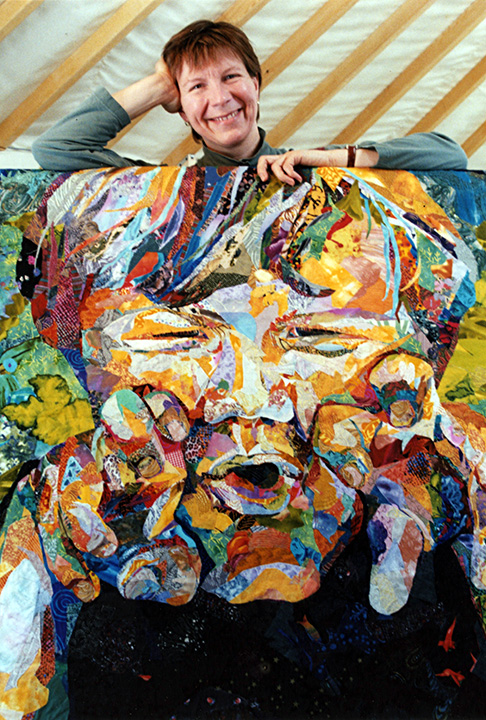
After working in such a realistic style for so long, the experience of working this looser way made me feel almost giddy. It was a playful, relaxed manner of creating that suited the subject.
When the image of Sam was complete, I began to contemplate the background. What color or colors would it be? The varying value of the piece made choosing a background thorny. If I chose a dark fabric the dark portions at the edge of the image would blend in too much. A light fabric would blend in with the lighter values.
After expressing this difficulty to my husband, he asked, “Why don’t you just keep collaging?”
“Because…”
There was no because.
So I kept on collaging. In that way, I could choose fabrics whose values contrasted with the image. The portrait of Sam, which had so much vibrancy thanks to the technique I had chosen, now had a background that matched that energy.
The naming of the quilt was pretty straightforward. What else could it be but “Samuelsaurus Rex”?
I think I achieved exactly what I was hoping to do with this quilt, which was to make it impressionistic rather than realistic. You really can’t tell what it is up close. You need distance for the image to come together.
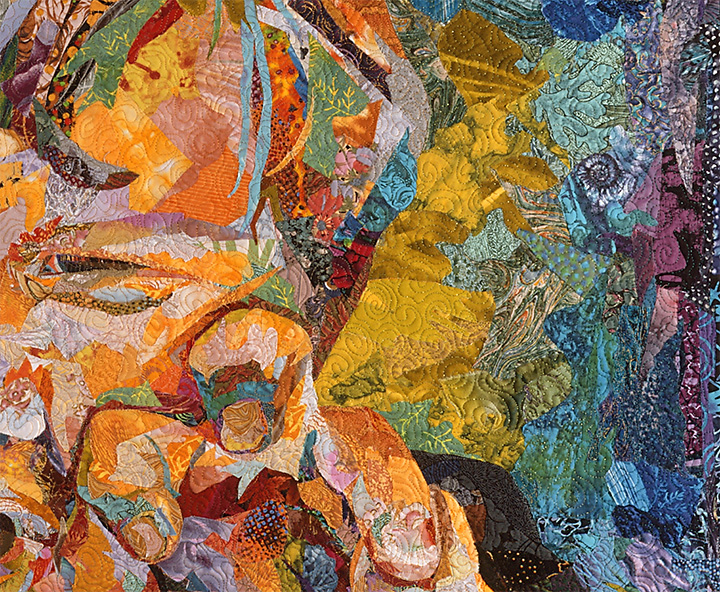
This was made evident one year when I had it displayed in the cramped hallway of the Button Factory Holiday Open House in Portsmouth, New Hampshire. Visitors strolling past commented on the colors in the piece, then they’d enter the studio nearby. When they came out from across hallway that’s when they’d see it.
“Look, it’s a boy. And look at the hands!” At which point they would imitate his pose.
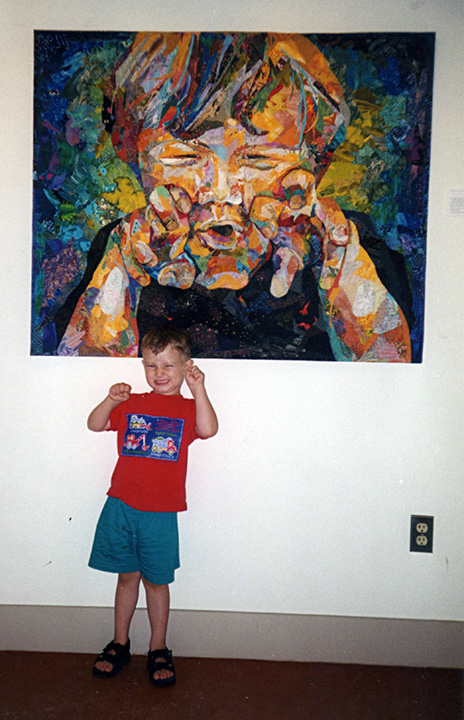
2010
A decade later, when Sam was thirteen, I created another portrait of him entitled “Peace, Love, Tie-Dye, Save the Whales.” I’ve written about this quilt in previous posts: “Making a Pattern for a Fabric Collage Quilt” and “Why Color Is Irrelevant”. I’ll tell the whole story of that quilt in a future blog. Let’s just say our little tree hugger loved the Beatles.
“Peace, Love, Tie-dye, Save the Whales” is included in a show close to home. Maine Fiber Arts is hosting an exhibit, “Innovations: Contemporary Art,” July 10-September 3, in its Topsham, Maine gallery, featuring fiber artists from all over Maine. A special reception will take place July 10, from 2-5 p.m.
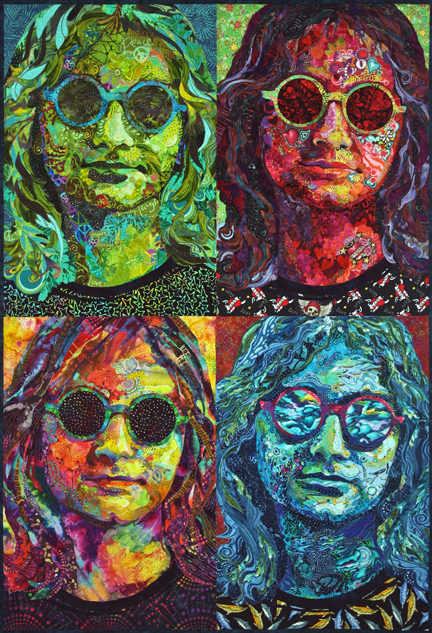
2020
So now I’ve established a pattern of producing a portrait of Sam every ten years, so when he turns 23, I plan to do another. Right now he’s in college with a degree in Musical Theater in his sights. With that in mind, I’ve started a pile of fabric for a potentially musical themed portrait. But I can wait to see where he’s at by then. I know that sometime about 4 years from now, the perfect photo of Sam will be taken, representing him at that moment in time, just like it has twice before.
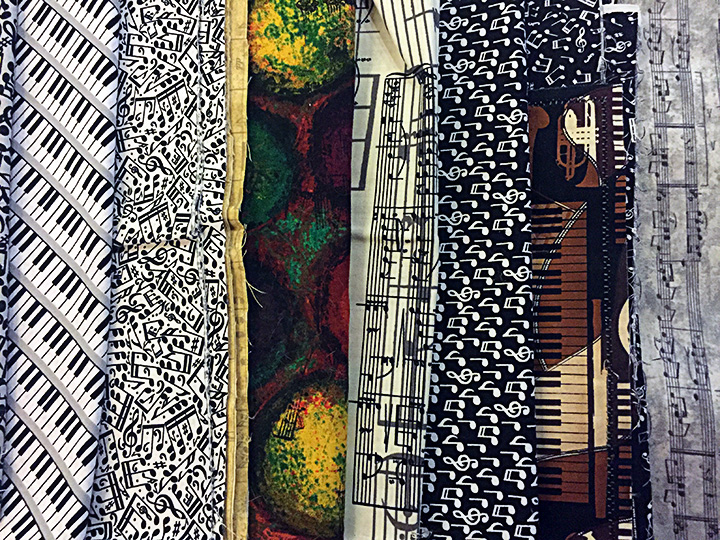

You are amazing, I so enjoy your e-mail and pictures and narrative. I just wish I could take a class with you, but am thankful for your sharing your experiences. Always in awe. Sandy Lewis
Susan…your work is amazing. I loved the photo of the scrap filled suitcase. Would you post the photo that you used for the latest “Sam” portrait?? You have to be SO proud of him. Would love to hear more about your yurt as studio…….. mickie
The picture of Sam that I used for “Peace, Love…” appeared in a previous blog post: “Making a Pattern for a Fabric Collage Quilt.”
I so would love to take a class from you! Just got my Quilting Arts magazine and see that you’re in it. Will have to take another trip to Maine some day….
I’m sure the third one of Sam will be just as amazing! We can’t wait to see it! Good luck Sam!
I loved this blog! Congrats on your new exhibition in Topsham!
Fascinating and extraordinary!
Hhmmm…you have also graduated from plastic bags to plastic recyclable salad bins, which we know Tom loves!
But vintage suitcases…delicious!
I love reading your blog and was thrilled to see the article in Quilting Arts. You’ve worked hard for so long and now you are being celebrated on the web and in print. Congrats. See you in October.
As always I really appreciate your commentaries. You remain, to me, my inspiration on my very slow journey in fabric collage. Thanks. Sue
Your art is so inspiring! I can’t wait to see Sam’s quilt with all the musical prints! I haven’t been able to take your class but have studied your books and your blog and videos and have improved my collage work, now on my 3rd collage quilt! I love your freehand cutting method!
Really like your collaged quilts.